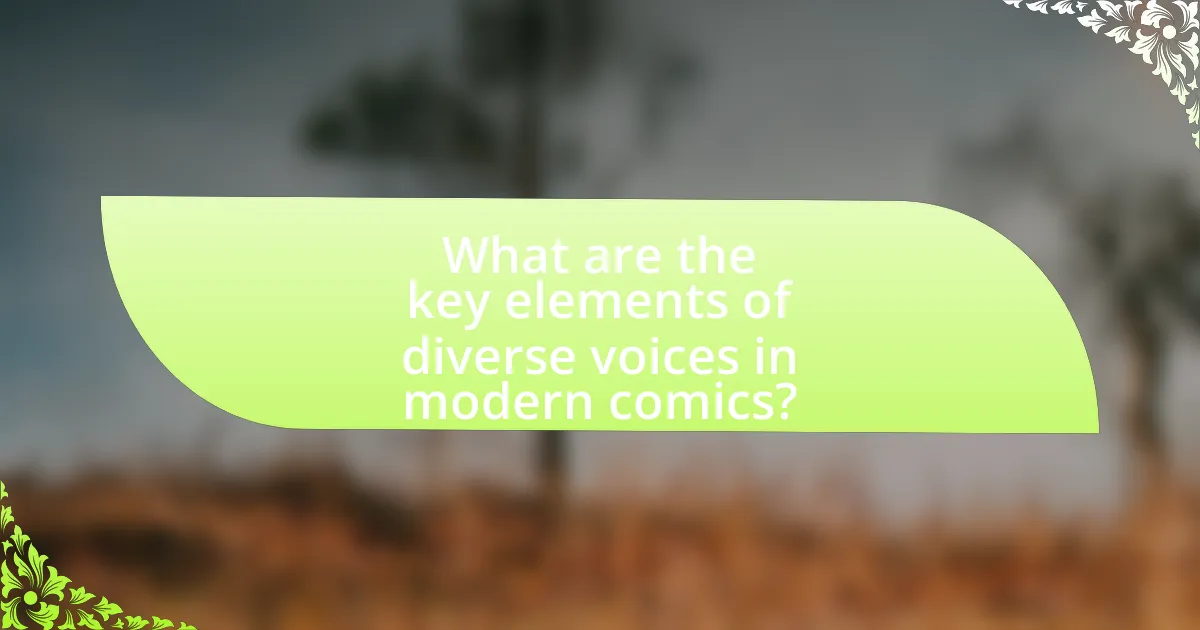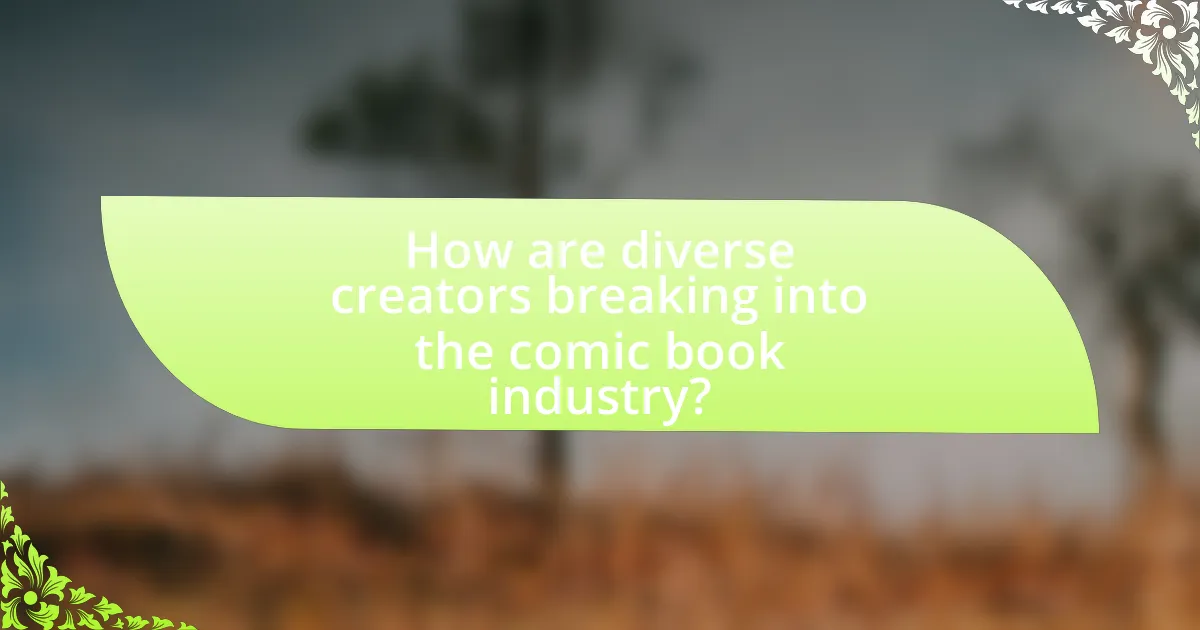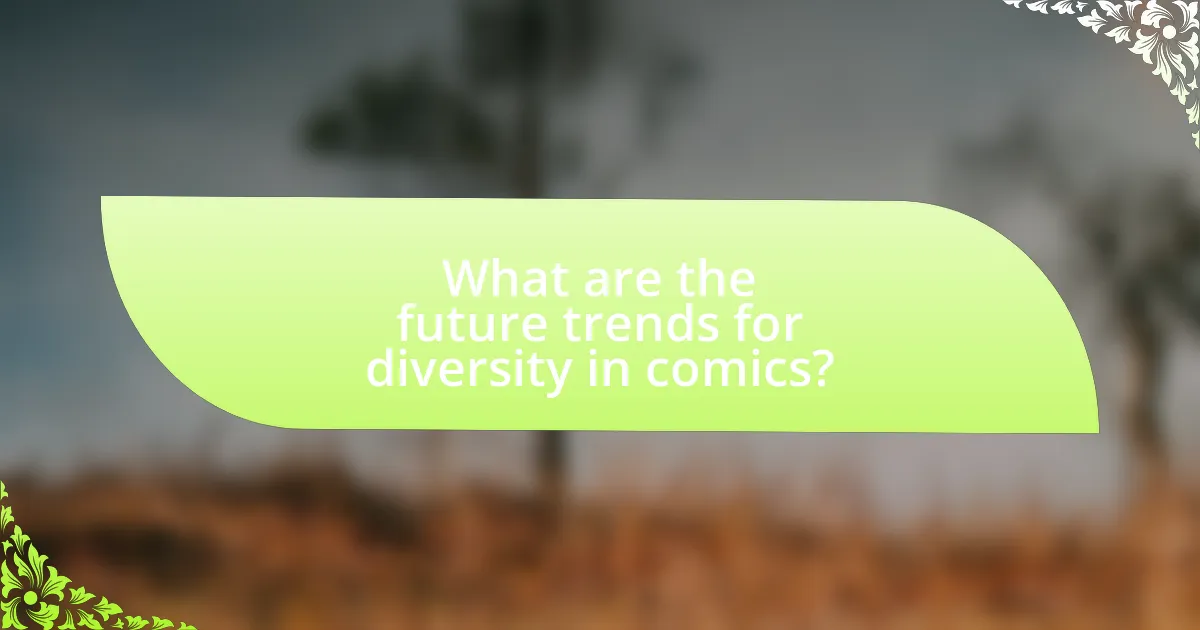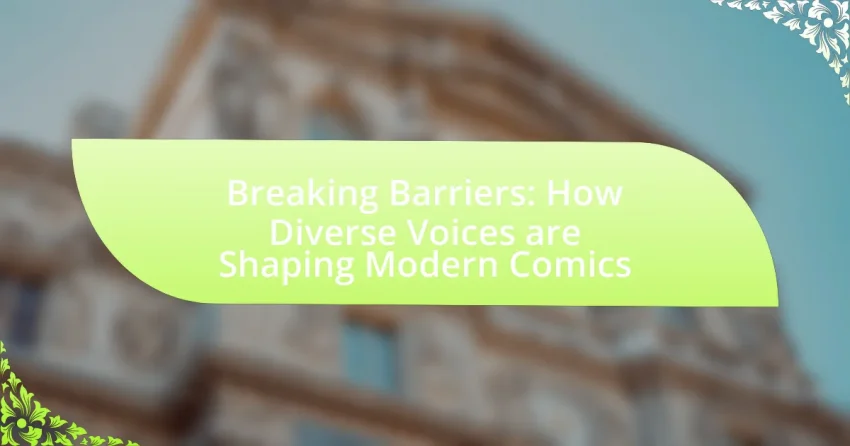The article “Breaking Barriers: How Diverse Voices are Shaping Modern Comics” examines the critical role of diverse voices in the comic book industry, highlighting key elements such as representation, cultural authenticity, and intersectionality. It discusses how these factors influence storytelling, character development, and audience engagement, showcasing successful titles like “Ms. Marvel” and “Black Panther.” The article also addresses the challenges faced by diverse creators, the impact of systemic barriers, and the initiatives aimed at supporting inclusivity in comics. Additionally, it explores the future trends for diversity in the industry and the importance of mentorship and collaboration in promoting underrepresented voices.

What are the key elements of diverse voices in modern comics?
The key elements of diverse voices in modern comics include representation, cultural authenticity, and intersectionality. Representation ensures that characters from various backgrounds, including race, gender, sexuality, and ability, are depicted, allowing a broader audience to see themselves in the stories. Cultural authenticity involves creators drawing from their own experiences and heritage, which enriches narratives and avoids stereotypes. Intersectionality recognizes that individuals have multiple identities that intersect, influencing their experiences and perspectives, thus creating more nuanced characters and plots. These elements collectively contribute to a richer, more inclusive comic landscape, as evidenced by the success of titles like “Ms. Marvel,” which features a Pakistani-American superhero, and “Black Panther,” which explores African culture and identity.
How do diverse voices influence storytelling in comics?
Diverse voices significantly influence storytelling in comics by introducing varied perspectives, themes, and cultural narratives that enrich the medium. This inclusion allows for a broader representation of experiences, which can resonate with a wider audience and challenge traditional storytelling norms. For instance, comics like “Ms. Marvel” by G. Willow Wilson feature a Pakistani-American superhero, reflecting the complexities of identity and cultural heritage, thereby expanding the scope of what stories can be told. Research indicates that diverse representation in media can lead to increased empathy and understanding among audiences, as seen in studies conducted by the Geena Davis Institute on Gender in Media, which highlight the importance of representation in shaping societal perceptions.
What themes are commonly explored through diverse perspectives?
Common themes explored through diverse perspectives in modern comics include identity, social justice, and cultural representation. These themes reflect the varied experiences and backgrounds of creators and characters, allowing for a richer narrative landscape. For instance, identity themes often delve into issues of race, gender, and sexuality, showcasing how these factors shape personal and communal experiences. Social justice themes address systemic inequalities and advocate for change, resonating with contemporary societal movements. Cultural representation themes highlight the importance of authentic portrayals of different cultures, fostering understanding and empathy among readers. These explorations are evident in works by creators such as Marjorie Liu and Gene Luen Yang, who incorporate their unique backgrounds into their storytelling, thereby enriching the comic medium.
How do character representations change with diverse voices?
Character representations change with diverse voices by incorporating a wider range of cultural backgrounds, experiences, and perspectives, which leads to more authentic and relatable characters. For instance, the introduction of characters like Miles Morales, a Black and Latino Spider-Man, reflects the growing demand for representation in comics, allowing readers from diverse backgrounds to see themselves in heroic roles. This shift not only enriches storytelling but also challenges traditional narratives, as evidenced by the increased popularity of titles that feature diverse protagonists, which have seen significant sales growth, indicating a market demand for such representations.
Why is representation important in the comic book industry?
Representation is important in the comic book industry because it fosters inclusivity and reflects the diverse experiences of readers. Diverse representation allows marginalized groups to see themselves in stories, which can enhance relatability and engagement. For example, the introduction of characters like Miles Morales, a Black and Latino Spider-Man, has expanded the audience and demonstrated that superheroes can come from various backgrounds. Studies show that diverse representation in media can positively impact societal perceptions and reduce stereotypes, making it crucial for the comic book industry to embrace a wide range of voices and experiences.
What impact does representation have on readers?
Representation significantly impacts readers by fostering a sense of belonging and validation. When readers encounter characters and stories that reflect their own identities, experiences, and cultures, they are more likely to feel understood and connected to the narrative. Research indicates that diverse representation in literature and media can enhance empathy and broaden perspectives among audiences. For instance, a study published in the journal “Psychological Science” found that exposure to diverse narratives can reduce prejudice and increase understanding of different social groups. This demonstrates that representation not only enriches the reading experience but also contributes to social cohesion and awareness.
How does representation affect the industry’s growth?
Representation significantly affects the industry’s growth by broadening the audience base and enhancing market reach. When diverse voices and characters are included in comics, they resonate with a wider demographic, leading to increased sales and engagement. For instance, the success of titles like “Ms. Marvel,” featuring a Muslim superhero, demonstrates that representation can attract new readers who see themselves reflected in the stories. According to a 2021 study by the Comic Book Legal Defense Fund, diverse representation in comics correlates with higher sales figures, indicating that inclusivity not only enriches storytelling but also drives economic growth within the industry.

How are diverse creators breaking into the comic book industry?
Diverse creators are breaking into the comic book industry through independent publishing, digital platforms, and increased representation in mainstream comics. Independent publishing allows creators from various backgrounds to produce and distribute their work without traditional gatekeepers, exemplified by successful crowdfunding campaigns on platforms like Kickstarter. Digital platforms, such as Webtoon and Tapas, provide accessible avenues for creators to reach audiences directly, leading to the rise of diverse narratives. Additionally, major publishers like Marvel and DC have begun to prioritize diversity in their hiring practices and storytelling, as seen in initiatives like Marvel’s “Voices” series, which highlights underrepresented voices. These combined efforts are reshaping the comic book landscape, making it more inclusive and reflective of a broader range of experiences.
What challenges do diverse creators face in the industry?
Diverse creators face significant challenges in the industry, including limited access to funding, representation, and market opportunities. These barriers often stem from systemic biases and stereotypes that marginalize their voices and contributions. For instance, a study by the University of California, Los Angeles (UCLA) in 2021 highlighted that only 12% of characters in popular comics are from underrepresented racial and ethnic groups, reflecting a lack of diversity in storytelling and character development. Additionally, diverse creators frequently encounter difficulties in networking and mentorship, which are crucial for career advancement. This lack of support can hinder their ability to break into mainstream markets and gain visibility for their work.
How do systemic barriers affect diverse voices in comics?
Systemic barriers significantly limit the representation of diverse voices in comics by creating obstacles in access to publishing opportunities, funding, and industry networks. These barriers often manifest through entrenched biases within the comic book industry, which historically favors mainstream narratives and creators from dominant cultural backgrounds. For instance, a 2019 study by the University of Southern California’s Annenberg Inclusion Initiative found that only 12% of comic book creators were from underrepresented racial and ethnic groups, highlighting the disparity in opportunities. Additionally, systemic issues such as lack of mentorship, financial support, and visibility for diverse creators further exacerbate the challenges they face in getting their stories told.
What initiatives are in place to support diverse creators?
Initiatives to support diverse creators in the comic industry include mentorship programs, grants, and diversity-focused publishing imprints. For example, organizations like the Comic Book Legal Defense Fund provide resources and legal support, while initiatives such as the D.C. Comics’ “We Are Heroes” program specifically aims to uplift underrepresented voices. Additionally, grants from entities like the Xeric Foundation offer financial assistance to diverse creators, enabling them to produce their work. These initiatives collectively foster an inclusive environment that encourages diverse storytelling and representation in modern comics.
How are independent comics contributing to diversity?
Independent comics are significantly contributing to diversity by providing platforms for underrepresented voices and stories that challenge mainstream narratives. These comics often feature protagonists from various racial, ethnic, and gender backgrounds, allowing creators to explore themes related to identity, culture, and social issues that are frequently overlooked in traditional publishing. For instance, the rise of independent publishers like Image Comics and smaller presses has led to the successful release of works such as “Ms. Marvel,” which centers on a Muslim-American superhero, showcasing the importance of representation in the medium. This shift not only broadens the scope of storytelling in comics but also fosters a more inclusive environment for readers, as evidenced by the increasing diversity of comic book audiences and the critical acclaim received by diverse titles.
What role do crowdfunding platforms play in supporting diverse voices?
Crowdfunding platforms play a crucial role in supporting diverse voices by providing creators from underrepresented backgrounds with the financial resources needed to bring their projects to life. These platforms enable individuals to bypass traditional funding barriers, allowing them to share unique stories and perspectives that may not be prioritized by mainstream publishers. For instance, a study by the University of Southern California found that projects led by diverse creators on crowdfunding platforms often receive higher engagement and support, demonstrating a demand for varied narratives in the comic industry. This financial backing not only empowers creators but also enriches the cultural landscape by introducing a wider array of voices and experiences to audiences.
How do independent comics differ from mainstream comics in terms of diversity?
Independent comics typically showcase greater diversity compared to mainstream comics, as they often prioritize underrepresented voices and narratives. This is evident in the variety of genres, themes, and characters that independent creators explore, reflecting a broader spectrum of cultural, social, and personal experiences. For instance, a study by the University of Southern California’s Annenberg Inclusion Initiative found that independent comics feature a higher percentage of creators from marginalized backgrounds, contributing to a richer tapestry of storytelling that challenges traditional norms. In contrast, mainstream comics frequently adhere to established formulas and character archetypes, which can limit the representation of diverse perspectives.

What are the future trends for diversity in comics?
Future trends for diversity in comics include an increase in representation of marginalized voices, particularly from communities such as LGBTQ+, people of color, and individuals with disabilities. This shift is driven by a growing demand for authentic storytelling that reflects the diverse experiences of readers. For instance, the success of titles like “Ms. Marvel,” featuring a Muslim superhero, demonstrates the market’s appetite for varied narratives. Additionally, independent publishers are emerging, focusing on diverse creators and stories, which further enriches the comic landscape. This trend is supported by industry reports indicating that diverse characters and creators lead to higher sales and broader audience engagement.
How is the audience’s demand for diversity shaping the industry?
The audience’s demand for diversity is significantly shaping the comic industry by driving publishers to prioritize inclusive storytelling and representation. This shift is evident in the increasing number of diverse characters and narratives that reflect a broader spectrum of experiences, such as the introduction of characters like Miles Morales, a Black and Latino Spider-Man, and the rise of titles featuring LGBTQ+ protagonists. According to a 2021 report by the Comic Book Legal Defense Fund, 67% of readers expressed a desire for more diverse characters in comics, indicating a clear market demand. As a result, major publishers like Marvel and DC have expanded their rosters to include creators from various backgrounds, fostering a more inclusive environment that resonates with a wider audience.
What are the emerging genres that highlight diverse voices?
Emerging genres that highlight diverse voices in modern comics include Afrofuturism, LGBTQ+ narratives, and Indigenous storytelling. Afrofuturism blends African culture with technology and science fiction, exemplified by works like “Black Panther” and “Nnedi Okorafor’s” graphic novels. LGBTQ+ narratives have gained prominence through titles such as “The Prince and the Dressmaker” by Jen Wang, which explores gender identity and acceptance. Indigenous storytelling is represented in comics like “Moonshot: The Indigenous Comics Collection,” showcasing the perspectives and experiences of Indigenous creators. These genres not only amplify underrepresented voices but also enrich the comic landscape with varied cultural insights and experiences.
How are digital platforms influencing the representation of diverse creators?
Digital platforms are significantly enhancing the representation of diverse creators by providing accessible avenues for content creation and distribution. These platforms, such as social media and webcomics, allow creators from various backgrounds to showcase their work without the traditional barriers imposed by the publishing industry. For instance, platforms like Webtoon and Tapas have reported a surge in diverse narratives, with creators from underrepresented communities gaining visibility and audience engagement. This shift is evidenced by the increasing number of comics that explore themes related to race, gender, and sexuality, reflecting a broader spectrum of human experiences. Additionally, data from a 2021 study by the Comic Book Legal Defense Fund indicates that diverse creators are more likely to find success on digital platforms compared to traditional print media, further validating the positive impact of these platforms on representation.
What best practices can be adopted to promote diversity in comics?
To promote diversity in comics, publishers and creators should prioritize inclusive storytelling, representation of diverse characters, and collaboration with creators from varied backgrounds. Inclusive storytelling involves crafting narratives that reflect the experiences and cultures of underrepresented groups, ensuring that these stories resonate authentically with diverse audiences. Representation of diverse characters means featuring protagonists and supporting characters from various ethnicities, genders, sexual orientations, and abilities, which can enhance relatability and broaden readership. Collaboration with creators from varied backgrounds not only brings fresh perspectives but also fosters an environment where diverse voices are heard and valued, as evidenced by the success of initiatives like the “We Need Diverse Books” campaign, which has significantly influenced the publishing landscape by advocating for diverse narratives.
How can established creators mentor diverse voices in the industry?
Established creators can mentor diverse voices in the industry by providing guidance, sharing resources, and creating opportunities for collaboration. By leveraging their experience, established creators can offer insights into the industry’s dynamics, helping emerging voices navigate challenges. For instance, mentorship programs and workshops led by seasoned creators have been shown to enhance the skills and visibility of diverse talent, as evidenced by initiatives like the “Creators for Change” program, which aims to empower underrepresented creators in various media. This structured support not only fosters talent development but also promotes inclusivity within the industry, ultimately enriching the storytelling landscape.
What strategies can publishers implement to enhance diversity?
Publishers can enhance diversity by actively seeking and promoting underrepresented voices in their content. This includes diversifying their author and illustrator rosters to reflect a broader range of cultural, racial, and gender identities. For instance, research from the Cooperative Children’s Book Center indicates that only 10% of children’s books published in 2018 featured characters of color, highlighting the need for increased representation. Additionally, publishers can implement mentorship programs for emerging creators from diverse backgrounds, ensuring they have the support and resources needed to succeed in the industry. By prioritizing inclusive hiring practices and creating partnerships with diverse organizations, publishers can foster an environment that values and amplifies diverse narratives, ultimately enriching the comic landscape.
